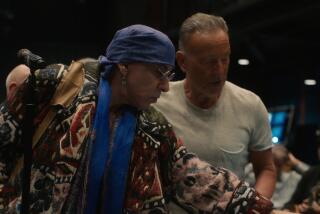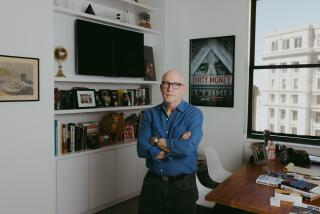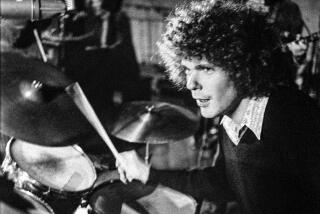FILM COMMENT : ‘The Doors’ and the ‘60s--A Fantasy
The real reason why there’s such a hot debate about whether “The Doors” is a masterpiece or a disaster is deceptively simple: Nobody can decide whether the decade of the ‘60s itself was a bust. Was it really an intoxicating era of heady idealism? Or was it a bad joke, an orgy of deluded flower-power, of acid freak-outs, bad bell-bottoms and even worse poetry?
That’s the problem with making movies about the ‘60s. In fact, that’s why so few people have even tried. The era is still weighted down with too much thorny cultural baggage. For people who came of age in the ‘60s, who can still remember their older brother saying, “Hey, it’s your trip, man,” the memories are too vivid, the scars too near the surface. We still have a hangover from all the wretched earnestness and excess.
Maybe that’s why there’s so much media uproar over “The Doors.” Twenty years after dying in a bathtub in Paris, Jim Morrison is on the cover of Esquire and the Village Voice. His band was a perfect flash point for the ‘60s--where the worlds of sex, rebellion and radical politics collided.
Even though “The Doors” lavishly recreates a host of ‘60s settings, from love-beaded Venice Beach to the original Whisky-A-Go-Go, director Oliver Stone has shrewdly kept his distance from the period issue. “The theme of the movie isn’t the ‘60s,” he said recently. “It’s Jim Morrison’s spiritual quest.”
But you can’t separate the Doors from their age. No band is a better barometer of the ‘60s’ idealist abandon and dopey hedonism. As Joan Didion once wrote: “The Doors were different. The Doors’ music insisted that love was sex and sex was death and therein lay salvation. The Doors were the Norman Mailers of the Top 40.”
Perhaps that’s why the band’s records sell better now than ever. The real Morrison, with all his silly shamanistic musings and boozy studio performances, has receded into the distant reaches of myth. In fact, today’s young fans have bought far more Doors albums (45 million as of this year) than the band’s original followers did.
It hardly matters that when novelist Eve Babitz was a young Venice hipster she pegged the Doors as hopelessly square nerds whose fans thought they were cool because “they had lyrics you could understand about stuff they learned in Psychology 101 and Art History.” (Don’t worry--that didn’t stop Babitz from sleeping with Morrison, as she reveals in this month’s Esquire.)
It hardly matters that when Rolling Stone compiled its official rock record guide that noted critic Dave Marsh dismissed the band as “the most overrated group in rock history,” laughing off “The End” as a “mistaken plunge into pomposity.”
It hardly matters that when my school chums and I saw the Doors’ infamous 1969 concert at Miami’s Dinner Key Auditorium we came away--die-hard fans all--writing them off as the lamest live act we’d seen since Jan & Dean.
The Doors’ reality--that they deteriorated badly after their second album--has long since been transformed into myth. Oliver Stone says that when Morrison died in 1971 “it was like the day J.F.K. died for me. It was that shattering.” When Francis Coppola wanted a dramatic accompaniment for the darkest moments of “Apocalypse Now,” he used “The End.”
The roster of Doors acolytes in the rock world includes a dean’s list of critic-faves ranging from Iggy Pop and Patti Smith to Joy Division, X and Billy Idol. If you couldn’t borrow from Morrison’s music, you could always act out his life. Perhaps Hollywood’s most eerily accurate rock biography, “Sid and Nancy,” chronicles the misadventures of the Sex Pistols’ Sid Vicious, who pursued Morrison’s death trip in real life.
So why is “The Doors,” despite all its clunky symbolism, the one ‘60s film that works, at least at crowd-pleasing myth-making? Probably because it’s a classic male adolescent fantasy, a noisy, sweeping assault of sensory thrills.
If I was 15 again, I’d love it. The concert scenes pulse with raucous energy, they’re crowded with nubile, naked women and reverberate with thundering music. The film evokes the giddy, carnival atmosphere of the late ‘60s with its doomed rock icon at center stage.
As Tom Wolfe once wrote, “Rock created a new kind of celebrity, the raw youth who ascended to stardom without having to pretend for a moment to be anything other than young and raw.”
No one did better justice to being young and raw than Jim Morrison. Seen through the eyes of Stone, Morrison is a hop-head first cousin of similar manic-obsessives in “Salvador,” “Talk Radio” and “Born on the 4th of July.” Addled with booze and coke, he drops acid in the desert, urinates on barroom floors, quotes Blake and Rimbaud, stomps on his Thanksgiving turkey and sips blood from wine goblets.
When I was 15, zonked on hash and listening to “Helter Skelter” on headphones at 2 a.m., drinking your beloved’s blood qualified as the height of cool. Is it any wonder that today’s disaffected high-schoolers still idolize Morrison? He’s the classic tortured adolescent hero, the ‘60s’ mind-bending answer to James Dean.
The only problem with “The Doors” is that if you’ve outgrown your fondness for overripe poetry and suicidal antics, if you’re old enough to rue the consequences of this full-tilt boogie lifestyle, the movie’s celebration of this anarchic behavior seems overwrought and--dare we say it?--faintly ridiculous.
In fact, for those of us who came of age in the late ‘60s, “The Doors” reminds us of our generation’s dirty little secret. With its love-ins and witches’ weddings, the era looks wildly silly in retrospect. Perhaps that’s why Hollywood--at least since the days of “Easy Rider”--has rarely attempted to bring the psychedelic era back to life. The ‘60s, with its unlikely marriage of utopian idealism and self-absorbed excess, was so immersed in pampered self-righteousness that it may always appear slightly ridiculous on screen.
Dozens of films have explored the nightmarish experience of Vietnam--and its aftershocks. But when it comes to capturing American youth culture in the ‘60s heyday, the list of recent entries is awfully thin. The most powerful evocations of ‘60s tumult have come from documentaries like “Gimme Shelter” and cinema verite style films like “Medium Cool.”
In the early 1970s, we saw a juicy crop of films laced with the druggy scent of Woodstock and Altamont: “Five Easy Pieces,” “Brewster McCloud,” “Taking Off” and “Carnal Knowledge.” Since then, Hollywood has kept its distance, preferring to explore the fall-out from the era, largely in the form of guilt-ridden nostalgia for lost values in “The Big Chill” and “Between the Lines.”
Why are the ‘60s still such a prickly subject? Hollywood has lavished attention on earlier eras, revisiting the screwball comedies and class struggles of the ‘30s, the moody, film noir visions of the ‘40s and the duck-tail delinquency of the ‘50s.
Before our era of instant media analysis it may have been easier for film to explore our immediate past. William Randolph Hearst was still alive--and at the height of his powers--when Orson Welles reinvented the newspaper tycoon as “Citizen Kane.” Labor violence was still rampant when Elia Kazan dramatized it in his Oscar-winning drama “On the Waterfront.”
As Malcolm Cowley once wrote of the turbulent 1930s: “The time between event and expression was so short that no one could miss their connection.”
So far, the ‘60s have avoided such intimate scrutiny. Today it’s TV that feeds on the dramas of our age. Of course, if “The Doors” is a box-office hit, you can expect the floodgates to open. But if Hollywood finally rediscovers the ‘60s, expect it to be packaged the same way Oliver Stone has depicted Morrison--with more ceremony than insight. In “The Doors,” Pamela Morrison introduces herself as the band’s “ornament.” But it’s really Jim Morrison who’s presented that way--as an alluring jewel of ‘60s crackpot idealism.
The movie simply magnifies the Doors myth more than ever. When it comes to exploring the import of the ‘60s, Stone follows the lead of the newspaperman in John Ford’s “The Man Who Shot Liberty Valance,” who advises: “When the legend becomes fact, print the legend.”
Who’s to say he’s wrong? But Stone’s myth-making makes better theater than art. If you strip away the tantalizing myths that surround the ‘60s, the real psychedelic swirl of excess and self-indulgence may still be too strong a potion for us to swallow.
More to Read
Only good movies
Get the Indie Focus newsletter, Mark Olsen's weekly guide to the world of cinema.
You may occasionally receive promotional content from the Los Angeles Times.









